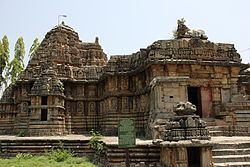Country India District Hassan District Architectural style Hoysala architecture | State Karnataka Time zone IST (UTC+5:30) | |
 | ||
Similar Lakshminarayana Temple - Hosaholalu, Kanakachalapathi Temple - Kanakagiri, Taj Mahal, Humanyun Mosque, Mysore Zoo | ||
The Someshvara temple at Haranhalli is an example of 13th century Hoysala architecture. Haranhalli is located about 35 km from Hassan city in Karnataka state, India. The temple was built in 1235 A.D. by the Hoysala Empire King Vira Someshwara. A few hundred meters from this temple is the more ornate Lakshminarasimha temple which also dates to the same period. The main deity in this temple is the Hindu god Shiva represented by his universal symbol, the linga. The temple is a protected monument under the Karnataka state division of the Archaeological Survey of India.
Contents
Overview
The temple plan is similar to that of the Lakshminarasimha temple, but according to art historian Foekema, it's overall decorative ornamentation is somewhat lesser in quality though there are some well executed reliefs. The temple plan is a ekakuta (single shrine) but made to look like a trikuta (three shrined) due to the two simple lateral shrine like structures. The main shrine is stellate (star shaped), has a complete superstructure (tower or shikhara) and a sukhanasi (nose or tower over the vestibule) which is similar to that in the Lakshminarasimha temple. The temple stands on a platform called jagati, a feature common to many Hoysala temples. The platform, in addition to adding visual beauty, provides the devotees a path for circumambulation (pradakshinapatha) around the temple. According to Foekema, the decoration in the interior of the temple and the upper parts of the walls deserves special mention for its taste.
Decoration and sculptures
The tower over the shrine and its vestibule (sukhanasi or nose) are intact. The kalasa on top of the tower (the decorative water-pot at the apex of the tower) is however missing. The decorative plan of the walls of the shrines and the hall is of the "new kind" (with two eaves that run around the temple). In the "new kind" of decorative articulation, the first heavy eaves runs below the superstructure and all around the temple with a projection of about half a meter. The second eaves runs around the temple about a meter below the first. In between the two eaves are the miniature decorative towers (Aedicula) on pilasters. Below the second eaves are the wall panel of images of Hindu deities and their attendants in relief. Below this, at the base are the six equal width rectangular moldings (frieze). Starting from the top, the friezes depict; hansa (birds) in the first frieze, makara (aquatic monsters) in the second, the usual depiction of scenes from the Hindu epics are absent in the third frieze which has been left blank. This is followed by leafy scrolls in the fourth frieze. The fifth and sixth friezes exhibit high quality workmanship in depicting horses and elephants respectively. Many blocks of the superstructure have no carvings. According to Foekema, in some places the frieze work on the moldings at the base is incomplete compromising its overall articulation.
